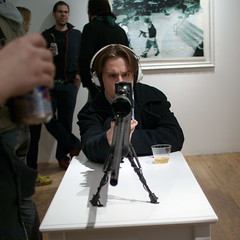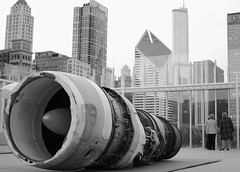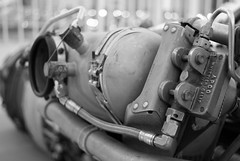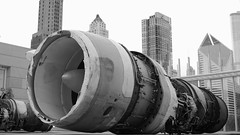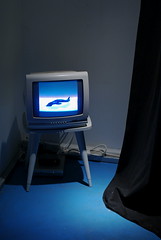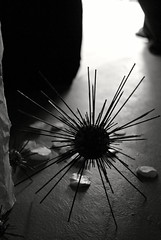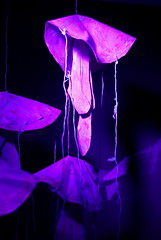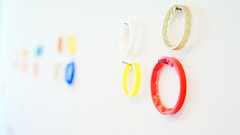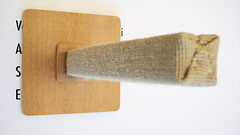Opening night, January 14, 2011: Entering through the storefront's glass curtain facade, Judy Ledgerwood's direct treatment of the surrounding solid walls has the effect of preparing a "color field" ground. Building upon that foundation she's brushed, freehand, a "lyrical" metallic paint figure, which in this context would be pleasing to consider as a lace motif. Continuing, her palette shifts from right to left, and top to bottom, while remaining tripartite in both the foreground and also the background.
 Above: Rhona Hoffman's clear, glass curtain wall, and Peoria St. entrance.
Above: Rhona Hoffman's clear, glass curtain wall, and Peoria St. entrance.
Within the piece, between the two distinct planes of action, there is high contrast: in hue, in value, in reflectivity, in painterliness, and in complexity of pattern. The result is a strong "op" effect. The large, nearly floor-to-ceiling, scale of the work is helpful in achieving its powerful, visual presence.[1] Not being bound by a frame, nor even by a single architectural surface: Where it occupies the whole of one's visual field the experience of the painting is like unto an immersion.
 Above: Judy Ledgerwood, "Chromatic Patterns for Chicago," 2011, detail
Above: Judy Ledgerwood, "Chromatic Patterns for Chicago," 2011, detail.
In sum, Ledgerwood's work upon the vertical, two-dimensional area of Hoffman's street-level gallery is immediately accessible, exposed to the variations of natural light, evident of the artist's own involvement, and, while connected to the history of painting and executed on a heroic scale, able to offer itself as playful, colorful and abstract.
That said, the defining experience of the exhibition is not to be found in that one space only, but rather in the dramatic movement from that starting point, upward, in an ascent into twilight.
 Above and below: Anne Wilson, "Rewinds," 2010.
Above and below: Anne Wilson, "Rewinds," 2010.
Elevated, at the other end of the building, in a windowless, blackened room, Anne Wilson's somber, three-dimensional installation awaits investigation. Therein, many small, achromatic or desaturated, glass elements lie carefully placed across horizontal surfaces: within vitrines or upon delicate plinths. Each was carefully wrought by a team of artisans; all are selectively lit by overhead spotlights. Control of light is as important, here, as was the handling of the (translucent) solid from which the objects were crafted.

During Wilson's first solo exhibition at Hoffman, in 2008, interest in the object category of "tool" was evident from the presence of a frame loom at the center of her noteworthy performance-sculpture "Wind-Up: Walking the Warp," even as an interest in the spatial distribution of phenomena was evident in the layout of her "Portable City" group from the same show.
 Above: Anne Wilson, "Wind-Up: Walking the Warp," 2008, post-performance.
Above: Anne Wilson, "Wind-Up: Walking the Warp," 2008, post-performance.
Then as now, Wilson co-ordinates the labor of others: seeming to be attentive to the worker's gender. While tools tend to be, and are here, interesting forms in their own right, it might also be good to remember that such implements appear at the nodal points of (at least some of) Wilson's historical interests: (1) labor; (2) gender; (3) parallel material and social organization. Those same three, longstanding, concerns remain manifest--only now in a different medium, with new connotations of value being derived from physical qualities of delicacy and semi-preciousness. Symbolically, tools bespeak laborers engaged in a particular craft. Though, yet again, Wilson's own role most closely resembles that of the architect.


With regard to that interpretation, "Blonde" is idiosyncratic and maybe confounding. More characteristic of what's understood to be the work of Wilson's own hand, "Blonde" is a vertical, hanging tapestry which incorporates her own hair of the same color. Maybe, whether intentional, it's a point of connection with the also flaxen-headed Ledgerwood, even as Ledgerwood's mural seems to nod at Wilson with a design imitative of a sagging, wall-mounted, horizontally-orientated textile.
 Above: Anne Wilson, "Blonde," 2011.
Above: Anne Wilson, "Blonde," 2011.
Ledgerwood too, for her part, makes difficult a simple reading as a result of her linear hanging of three-dimensional, non-objective, polyurethane "Blob Paintings" in red, yellow, green and blue. The (partial?) representation of the visual spectrum seems indicative of the careful nature of the pieces' irrationality; the material has been previously employed by Ledgerwood's partner Tony Tasset.
 Above: Judy Ledgerwood, "Blob Painting," in blue.
Above: Judy Ledgerwood, "Blob Painting," in blue.
Considering the whole, it's the successful synthesis of an environment, and not only a discrete object, which in this place connects Judy Ledgerwood to Anne Wilson. The two seem otherwise somewhere near antipodes: as much in formal terms as in their artworks' respective locations across the site. The range of visually interesting material available is probably the (two-part) show's greatest strength, and certainly not its weakness. It's very much worth seeing.
[1] Describing Ledgerwood's "Chromatic Patterns for Chicago," writers have moved beyond the realm of the visual: Lori Waxman, January 21, 2011, Chicago Tribune, wrote of the "icy cool rush" and "agitated jangle" produced by the "loud, metallic, fluorescent," paint which "rustles and twinkles" in the light, even as Janina Ciezadlo, January 17, 2011, Newcity, commented upon the "heat and light" produced by the artwork.
Anne Wilson
"Rewinds"
Judy Ledgerwood
"Chromatic Patterns for Chicago & Blob Paintings"
January 14—February 18, 2011
Tuesday-Friday, 10am-5:30pm
Saturday, 11am-5:30pm
Rhona Hoffman Gallery
118 North Peoria Street
Chicago, Illinois 60607
http://www.rhoffmangallery.com
- Paul Germanos



























